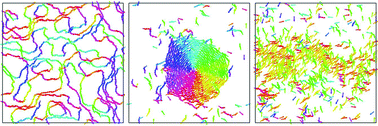Emergent vortices and phase separation in systems of chiral active particles with dipolar interactions
Abstract
Using Brownian dynamics (BD) simulations we investigate the self-organization of a monolayer of chiral active particles with dipolar interactions. Each particle is driven by both, translational and rotational self-propulsion, and carries a permanent point dipole moment at its center. The direction of the translational propulsion for each particle is chosen to be parallel to its dipole moment. Simulations are performed at high dipolar coupling strength and a density below that related to motility-induced phase separation in simple active Brownian particles. Despite this restriction, we observe a wealth of phenomena including formation of two types of vortices, phase separation, and flocking transitions. To understand the appearance and disappearance of vortices in the many-particle system, we further investigate the dynamics of simple ring structures under the impact of self-propulsion.



 Please wait while we load your content...
Please wait while we load your content...